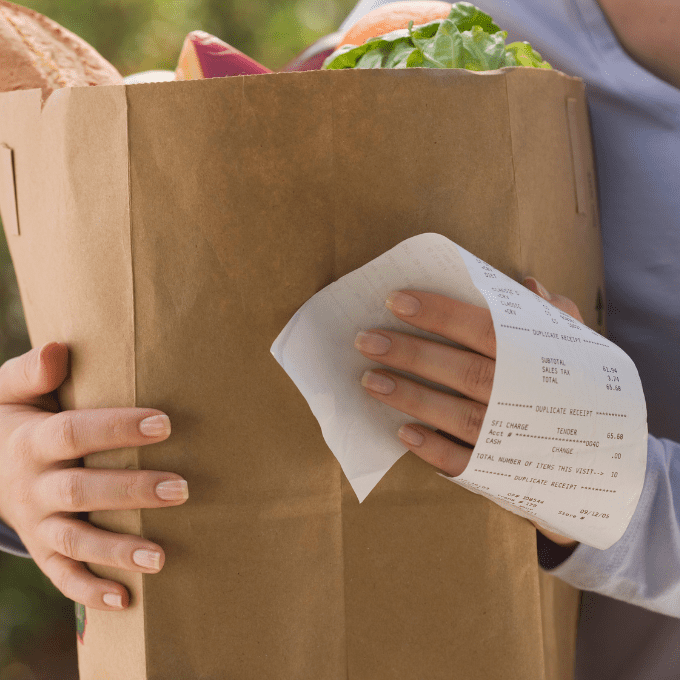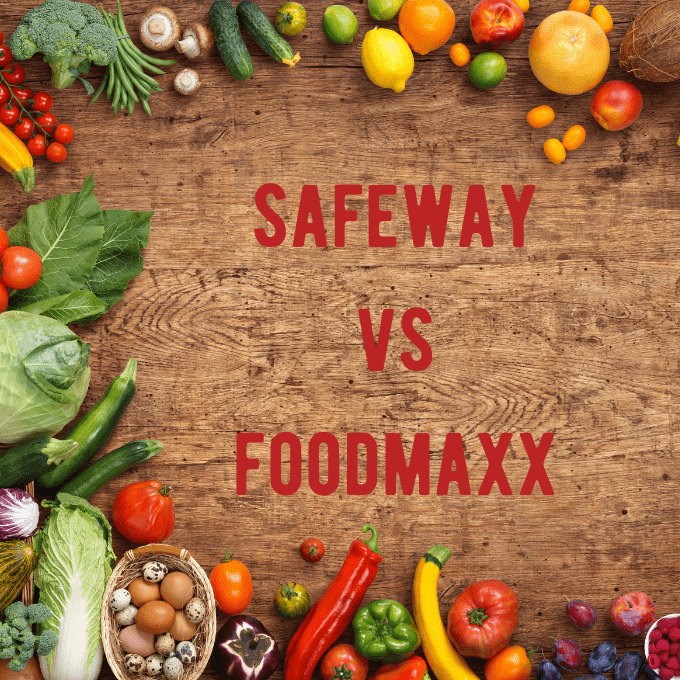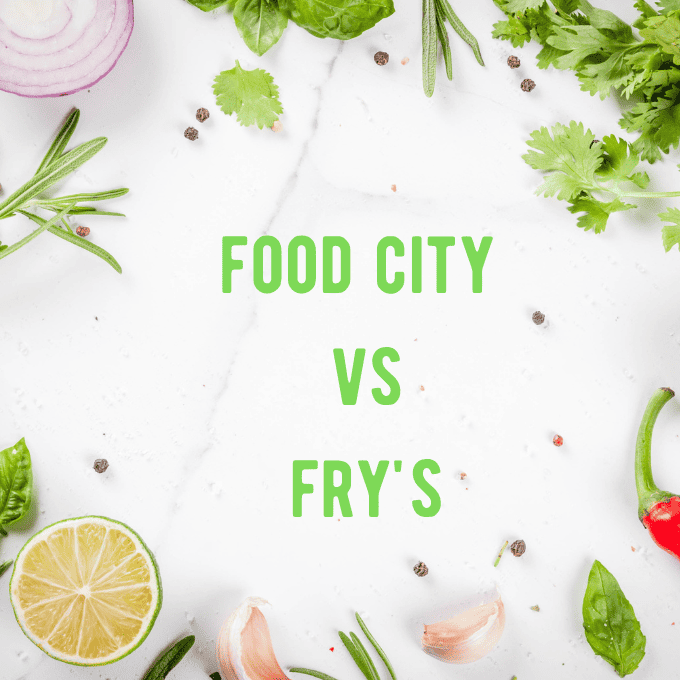18 Easy Ways to Cut Your Grocery Bill
Most of the expenses that we have every month can’t be changed, but you can adjust your grocery bill. This is getting harder but not impossible with food prices continuing to soar.
I am going to go over the ways that I use to constantly lower my costs for groceries. You may not want or need to do them all, but by doing a few you can definitely see some improvement on your grocery budget!

How do I cut my weekly groceries?
There are lots of small ways that you can reduce your grocery bill every week, and we will break down the easiest ones that anyone can do! These are tried and true ways that don’t really require that much time and no extreme couponing either.
1. Shop your Pantry & Freezer First
Before you head to the grocery store, check out what you have on hand first. I can’t tell you the number of times I have bought a condiment or a dry good, only to find out I already had some. You can make an inventory have what you have in your freezer and pantry, so that way you know what you have. I like to keep mine on the fridge, so I always know where it is.
2. Meal Planning
Meal Planning is a game changer for saving money on groceries. Going to the grocery store with a list can definitely make you spend less, but if you only buy the items needed to complete a meal plan than you can save even more! Check out our sample meal plans that typically cost around $100.
We also offer a full print at home meal planning kit that includes a grocery list, meal planner, and inventory sheets for pantry/freezer/cabinets/household items.

3. In Season Produce
A lot of us plan our meals based on what we want to eat. If we shift our focus into using in season produce, you can really save more money at the grocery store. Asparagus or eggplant might sound really yummy, but if it is not on sale we will pay a premium price for it.
4. Only Buy Meat on Sale
Meat prices fluctuate week to week, so it is very important to buy meat when it is on sale for the lowest price possible. Some weeks chicken breasts can be as high as $6.99 a pound and next week it will be on sale for $2.99 a pound. When it is on sale is the time to stock up so you can have chicken or any other meat later.
5. Skip Convenience Meals and Products
Most convenience meals and products are just very high priced and honestly not that healthy due to the preservatives like salt in them. Examples of these products are bags of chopped salad, Hamburger Helper kits, premade mashed potatoes, and cans of cream of chicken soup. These can all be made at home quickly and cost a lot less than buying them!
6. Stock up on Basics when at a Good Price
When you do notice items you regularly buy go on sale, consider stocking up on them for later. I already mentioned buy meat when on sale, but this applies to dry goods as well. I regularly wait to buy things like barbeque sauce, peanut butter, pasta, and rice when they are on sale.
I typically buy enough to last for about 3 months. This is because grocery stores typically work on 12-week cycles, and about every 3 months the items will go on sale again.

7. Get Creative (try new stores)
One of the biggest mistakes I have made when grocery shopping is only shopping at one store. A simple Google search of “grocery stores near me” will bring up all the stores that sell food near your house. I have since found many small ethnic markets that can be quite cheaper than the larger grocery stores.
8. Re-Purpose Leftovers
I am not always a big fan of eating the same thing more than twice, so I like to get creative with my leftovers. I will turn a roasted chicken into chicken soup, pulled chicken tacos, and then if any is left, I will make a buffalo chicken dip for lunch. So that one chicken could potentially make 4 separate meals for my family. I could have eaten just roasted chicken for 4 meals, but I like a little variety!
9. Back to Basics/Simple Dishes
One of the true tricks to eating cheaper and keeping it healthy is to make simple dishes that don’t require a lot of ingredients.
10. Skip the Extra Packaging
I know that it is easier to buy snacks in small individual packs, but you end up paying a ton for the extra packaging. Whenever possible, I like to buy a big big of snacks like pretzels or chips, and portion them out into small bags.
I usually stock up on Ziploc bags of all sizes from my local dollar tree. This ensures that I have every size that I will possibly need from snack size to 2.5-gallon size. When I send snacks to school, I just portion out enough for a snack size bag and put them in my kid’s bag. (Pro Tip: my kids can’t always open a small bag of chips, but they can open a Ziploc baggie, so this works really well!)
11. Ditch the Drinks
I know from experience that drinks like soda, juice, sports drinks, and premade sweet tea can really add up each week. I have started cutting out the sugary high calorie drinks with options I can make at home.
We have started making sweet tea, lemonade, and flavored water at home. This is a huge savings. I initially resisted this because I like the individual bottles for when I away from home, so I bought some travel cups that keep drinks cold and that problem was solved.

12. Price Compare
Comparing prices is easily one of the major ways to save money. Most grocery stores have apps now where you can compare prices on almost every item they sell. My favorite app is the Walmart app, because I use it all the time to compare prices while I am in another store.
For example, if i see shampoo is on sale at Dollar General, I will look up the regular price at Walmart to see if the sale price is better. This keeps me from having to remember every price of every item that we typically buy.
Walmart is almost always cheaper on food and beauty products, so this is my baseline that I use to determine if a price is a good deal.
13. Buy Household Items Separately
Did you know that the household products you buy at the grocery store even on sale are usually overpriced for the sake of convenience? Most grocery stores know that you want to go to one place and get everything you need, so they offer household products at a premium price.
Common overpriced items in the grocery store are cleaning supplies, laundry products, and home improvement stuff like light bulbs and air filters. You can purchase these same items at stores like Dollar General, Walmart, and even hardware stores for much cheaper.
I regularly buy household items and medications at Dollar General on Saturdays so I can use their $5 off a $25 purchase coupon. They also usually have some good digital coupons on their app as well.
Don’t forget extra savings by using loyalty cards and store apps for coupons!
14. Go Homemade
There are so many items that you can make at home that not only taste better but are so much cheaper. Most of these dishes don’t take any more time than buying the premade item or kit.
Good examples of this would be making your own Montreal Steak Seasoning, Graham Cracker Crust, and Chex Mix. They don’t take very much time to make, and the savings can really add up over time.

15. Don’t be Afraid of Substitutions
So many of us get so stuck on what a recipe calls for that we feel like we can’t even attempt it if we don’t have all the ingredients. Instead of going to the store for the missing parts, try substituting what you already have on hand.
This is one of the reasons that I post ideas and formulas about dishes and not full recipes. This is because recipes are not set in stone, and can be easily adjusted and tweaked to your own liking.
For example, if you want to make chili but don’t have tomato paste, you can easily substitute it with ketchup, tomato sauce, or tomato puree from canned tomatoes. You can literally find tons of substitutions for many common recipe ingredients.
This also includes cuts of meat. If you want to make a ranch fajita chicken but don’t have chicken breasts, you can easily substitute chicken thighs or chicken tenderloins. Don’t skip a recipe because you don’t have the exact items, adjust it to what you do have.
16. Date your Pantry & Freezer
If you have seen our expired food experiments, you may have noticed that we found a ton of expired food in our pantry. This was partly because I was overbuying when things were on sale and because of poor pantry inventory management.
Now I try to only buy enough for the next 3 months, and I will not only write the date on packaging, I will also arrange the items so the oldest items are in front. If you constantly put new product in front of old product, you will eventually end up with a bunch of expired food items.

17. Manager’s Special
Now that I have my pantry and freezer mainly stocked, I can really go after some surprise good deals at the grocery store. Almost every store has a clearance section for the whole store, or a separate rack or table for each section.
For example, Walmart usually has a rack of bakery items that are marked down near the dairy section in my store. Two of my local stores, mark down produce by putting large stickers on the product on the shelf.
Even if I am not going for produce or meat, I will routinely walk around each of the sections in the grocery store to see if there are any Manager’s Specials or markdowns that are a great price. Not every clearance item is a good deal, but some can be an amazing deal.
Recently, we stumbled upon 4lb bags of frozen meatballs for $4 at Kroger. That is an amazing deal, so we actually bought 5 bags! Thankfully we have enough space in our deep freezer for that much. Another good thing is to think how you can use the product in various ways.
You may be thinking we will be eating spaghetti and meatballs for the next 4 months, but actually we have turned these meatballs in many different dishes. Like sweet and sour meatballs over rice, meatball subs, used them for homemade chili mac, and even diced them up and added them to cheesy quiche!
18. Cook Smaller Amounts
We used to have a bad habit of always using all of a package to make one dish. For example, I used to make spaghetti and use a whole box of noodles. This always ended with a huge amount of spaghetti going to waste. Now I will use 1/3 to 1/2 a box of noodles when I make a dish.
To keep the open box of noodles from going bad, I store it in a ziploc plastic bag until I make another pasta dish. This means I can also use less sauce and meat for my dish because I am not using as many noodles. This can apply to making taco meat, chili, and even soup too.
Another example of this is we have found that no one really likes leftover rice because it gets hard and crunchy. I used to use 2 cups of dry rice to make a dish which ends up with almost 6 cups of cooked rice. This was constantly getting tossed so, we started just making 3/4 of a cup of rice at a time, and we have just enough for dinner and leftovers for lunch.

Grocery Hacks to Save Money
None of these suggestions are particularly mind blowing but they do include a shift in perspective. We have to be more mindful and organized if we want to get the most food for our bucks.
I have been doing this for over 20 years, and I didn’t get really good at it overnight. I really started with one or two ideas and slowly built up more frugal shopping skills.
By using these grocery hacks, I typically spend less than $400 a month for groceries. This may sound really low, but I could easily spend less by only using what I have on hand.
We aren’t prepping for a disaster but if needed we could probably eat fine for 3-6 months on what we have in the pantry and freezer without buying anything at the grocery store. The meals may get boring, but everyone would be fed.
My last piece of advice is to gradually lower your set grocery budget. If you currently spend $300 a week, next week put your limit at $270. In another few weeks, lower it again to $240.
When we try to cut categories too fast, we end up feeling resentful and are not as willing to stick to the plan. We don’t want just small, short-term results, we want lots of long-term savings on money!







